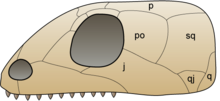無孔亞綱
無孔亞綱(Anapsida)属于羊膜動物,頭骨上没有颞颥孔[1]。牠們是羊膜动物中最原始的一群,出现于石炭纪晚期。由于龜鱉目演化自雙孔亞綱,所以無孔亞綱全部灭绝,其中的米勒古蜥科、夜守龍科、鋸齒龍科,都在二疊紀-三疊紀滅絕事件中絕種,只有前稜蜥科仍存活到三疊紀。 無孔亞綱是種傳統上的用法,有學者提出這些無孔類動物的彼此關係很遠,所以應該被分為幾個演化支:出現在晚石炭紀的原始爬行動物(大鼻龍目)、生存在二疊紀的多樣性無孔類爬行動物(前稜蜥形目)、以及現存的龜鱉目(海龜、陸龜、水龜)。
| 无孔亚纲 化石时期:
| |
|---|---|

| |
| 無孔亞綱頭顱骨 | |
| 科学分类 | |
| 界: | 动物界 Animalia |
| 门: | 脊索动物门 Chordata |
| 纲: | 爬行綱 Reptilia |
| 亚纲: | †无孔亚纲 Anapsida Williston, 1903 |
| 目 | |
最早的龜鱉目化石來自晚三疊紀中國的半甲齒龜(Odontochelys semitestacea),已經很類似現代烏龜。近年有科學家提出,龜鱉目的無孔類形態頭顱骨,是種演化逆行現象。這個理論認為龜鱉目演化自雙孔類爬行動物,在演化過程中失去兩個颞颥孔,這理論還已经被普遍的接受。近期的一些種系發生學研究,根據形態學而將龜鳖目歸類於雙孔亞綱[2][3][4]。一些研究人員將龜鱉目列為主龍類的姊妹分類單元[5][6],其中多數研究人員是將龜鱉目歸類於鱗龍形下綱[7][8][9][10][11]。
大部分分子系統發生學的研究結果,都支持龜鱉目屬於雙孔亞綱的分類法。某些研究將龜鱉目歸類於主龍類[12],大部分研究則是將龜鱉目列為主龍類的姊妹分類單元[13][14][15][16][17]。另有一個分子系統發生學研究,將龜鱉目歸類於雙孔亞綱的鱗龍形下綱,是鱗龍類(蜥蜴、蛇、喙頭蜥)的近親[18]。他們認為龜鱉目原先被歸類於無孔亞綱的原因,是因為原本研究是將龜鱉目作為無孔亞綱的研究主體、參照點,而且原本研究並沒有廣泛地研究遠古無孔類的化石、現存龜鱉目的骨頭,以建立演化樹。有研究認為,龜鱉目是在2億7900萬到2億年前演化自雙孔類爬行動物。[7][13][19]。
參考資料
编辑- ^ Pough, F. H. et al. (2002) Vertebrate Life, 6th Ed. Prentice Hall Inc., Upper Saddle River, NJ. ISBN 978-0-13-041248-5
- ^ deBraga, M. and Rieppel, O. (1997). "Reptile phylogeny and the interrelationships of turtles." Zoological Journal of the Linnean Society, 120: 281-354.
- ^ Linda A. Tsuji and Johannes Muller. Assembling the history of the Parareptilia: phylogeny, diversification, and a new definition of the clade. Fossil Record. 2009, 12 (1): 71–81 [2012-12-21]. doi:10.1002/mmng.200800011. (原始内容存档于2017-10-09).
- ^ Marcello Ruta, Juan C. Cisneros, Torsten Liebrect, Linda A. Tsuji and Johannes Muller. Amniotes through major biological crises: faunal turnover among Parareptiles and the end-Permian mass extinction. Palaeontology. 2011, 54 (5): 1117–1137 [2012-12-21]. doi:10.1111/j.1475-4983.2011.01051.x. (原始内容存档于2017-08-23).
- ^ Susan E. Evans. An early kuehneosaurid reptile (Reptilia: Diapsida) from the Early Triassic of Poland (PDF). Paleontologica Polonica. 2009, 65: 145–178 [2012-12-21]. (原始内容存档 (PDF)于2020-11-06)..
- ^ Magdalena Borsuk−Białynicka; and Susan E. Evans. A long−necked archosauromorph from the Early Triassic of Poland (PDF). Paleontologica Polonica. 2009, 65: 203–234 [2012-12-21]. (原始内容存档 (PDF)于2020-11-06).
- ^ 7.0 7.1 Rieppel O, DeBraga M. Turtles as diapsid reptiles. Nature. 1996, 384 (6608): 453–5. doi:10.1038/384453a0.
- ^ Li, Chun; Xiao-Chun Wu, Olivier Rieppel, Li-Ting Wang & Li-Jun Zhao. An ancestral turtle from the Late Triassic of southwestern China. Nature. 2008-11-27, 456 (7221): 497–501. PMID 19037315. doi:10.1038/nature07533.
- ^ Constanze Bickelmann, Johannes Müller and Robert R. Reisz. The enigmatic diapsid Acerosodontosaurus piveteaui (Reptilia: Neodiapsida) from the Upper Permian of Madagascar and the paraphyly of ‘‘younginiform’’ reptiles. Canadian Journal of Earth Sciences. 2009, 49: 651–661. doi:10.1139/E09-038.
- ^ Robert R. Reisz, Sean P. Modesto and Diane M. Scott. A new Early Permian reptile and its significance in early diapsid evolution. Proceedings of the Royal Society B. 2011, 278 [2012-12-21]. doi:10.1098/rspb.2011.0439. (原始内容存档于2016-06-29).
- ^ Li, Chun; Olivier Rieppel, Xiao-Chun Wu, Li-Jun Zhao and Li-Ting Wang. A new Triassic marine reptile from southwestern China. Journal of Vertebrate Paleontology. 2011, 31 (2): 303–312. doi:10.1080/02724634.2011.550368.
- ^ Mannena, Hideyuki; Li, Steven S. -L. Molecular evidence for a clade of turtles. Molecular Phylogenetics and Evolution. Oct 1999, 13 (1): 144–148. PMID 10508547. doi:10.1006/mpev.1999.0640.
- ^ 13.0 13.1 Zardoya, R.; Meyer, A. Complete mitochondrial genome suggests diapsid affinities of turtles. Proc Natl Acad Sci U S A. 1998, 95 (24): 14226–14231. ISSN 0027-8424. PMC 24355 . PMID 9826682. doi:10.1073/pnas.95.24.14226.
- ^ Iwabe, N.; Hara, Y.; Kumazawa, Y.; Shibamoto, K.; Saito, Y.; Miyata, T.; Katoh, K. Sister group relationship of turtles to the bird-crocodilian clade revealed by nuclear DNA-coded proteins. Molecular Biology and Evolution. 2004-12-29, 22 (4): 810–813 [2010-12-31]. PMID 15625185. doi:10.1093/molbev/msi075. (原始内容存档于2016-04-12).
- ^ Roos, Jonas; Aggarwal, Ramesh K.; Janke, Axel. Extended mitogenomic phylogenetic analyses yield new insight into crocodylian evolution and their survival of the Cretaceous–Tertiary boundary. Molecular Phylogenetics and Evolution. Nov 2007, 45 (2): 663–673. PMID 17719245. doi:10.1016/j.ympev.2007.06.018.
- ^ Katsu, Y.; Guillette; Braun, E. L.; Guillette, L. J. Jr.; Iguchi, T. From reptilian phylogenomics to reptilian genomes: analyses of c-Jun and DJ-1 proto-oncogenes. Cytogenetic and Genome Research. 2010-03-17, 127 (2–4): 79–93. PMID 20234127. doi:10.1159/000297715. Authors list列表缺少
|last2=(帮助) - ^ Crawford, N. G.; Faircloth, B. C.; McCormack, J. E.; Brumfield, R. T.; Winker, K.; Glenn, T. C. (2012). "More than 1000 ultraconserved elements provide evidence that turtles are the sister group of archosaurs". Biology Letters. doi:10.1098/rsbl.2012.0331
- ^ Tyler R. Lyson, Erik A. Sperling, Alysha M. Heimberg, Jacques A. Gauthier, Benjamin L. King and Kevin J. Peterson. MicroRNAs support a turtle + lizard clade. Biology Letters: 104–107. [2012-12-21]. doi:10.1098/rsbl.2011.0477. (原始内容存档于2018-10-31).
- ^ Benton, M. J. Vertebrate Paleontology 2nd. London: Blackwell Science Ltd. 2000. ISBN 0-632-05614-2., 3rd ed. 2004 ISBN 978-0-632-05637-8
參見
编辑外部連結
编辑- 化石網-古爬行動物博物館[失效連結]
- Introduction to Anapsida (页面存档备份,存于互联网档案馆) from UCMP